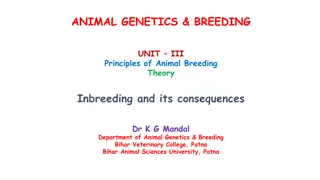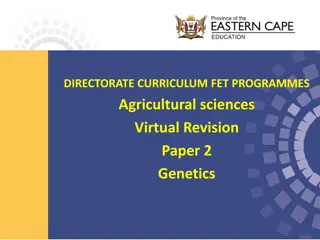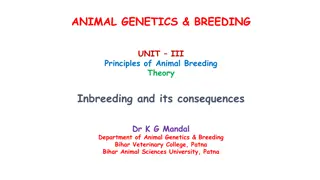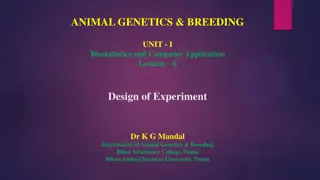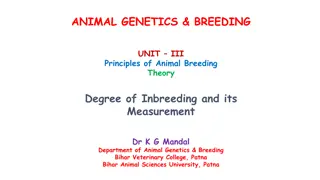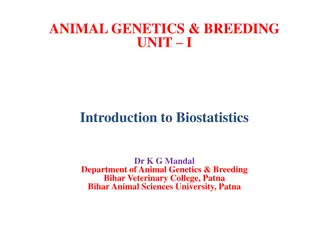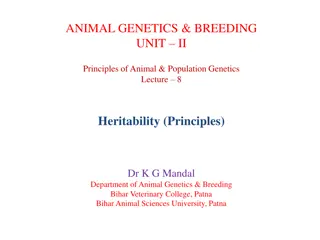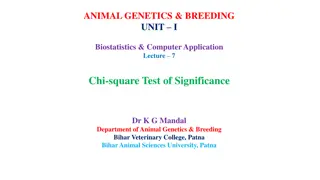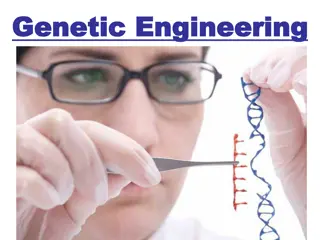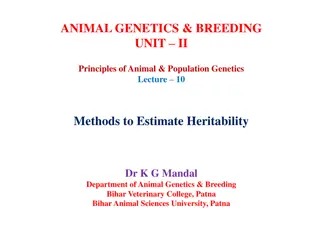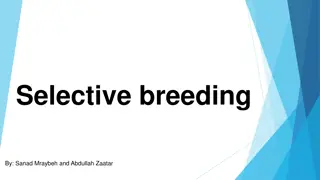Understanding Selection Strategies in Animal Genetics and Breeding
Genes influence traits through Additive Gene Action (AGA) and Non-Additive Gene Action (NAGA) in animal breeding. Recurrent Selection (RS) and Reciprocal Recurrent Selection (RRS) play crucial roles in improving animals. Selection for General Combining Ability (GCA) and Specific Combining Ability (SCA) helps in maximizing genetic potential. The importance of combining abilities, selection systems, and mating schemes are discussed for enhancing breeding values in animals.
Download Presentation

Please find below an Image/Link to download the presentation.
The content on the website is provided AS IS for your information and personal use only. It may not be sold, licensed, or shared on other websites without obtaining consent from the author. Download presentation by click this link. If you encounter any issues during the download, it is possible that the publisher has removed the file from their server.
E N D
Presentation Transcript
BIHAR ANIMAL SCIENCES UNIVERSITY, PATNA, BIHAR Bihar Veterinary College, Patna Recurrent(RS) and Reciprocal Recurrent Selection (RRS) Speaker: Ramesh Kumar Singh Assistant Professor cum Jr. Scientist Division of Animal Genetics and Breeding Bihar Veterinary College, Patna
Introduction Genes carried by an individuals (Genotypes) for particular trait act in different ways to produce their effect. Gene actions = Additive Gene Action (AGA) + Non- Additive Gene Action (NAGA) AGA = Breeding Value NAGA = Allelic interaction within locus (Dominance and Over-Dominance) + Non-allelic interaction Between locus (Epistasis) Traits = product of mixed effect of AGA, NAGA and Environment
Contd.. As a result of NAGA of genes, an individual in certain mating combinations has a special breeding value. If phenotype of Aa individuals deviates in any direction other than mid point, the effects is said to be due to NAGA. Selection theories for AGA and NAGA are different. Selection systems which maximize both AGA and NAGA should be followed.
Selection for COMBINIG ABILITY The procedure of crossing lines to produce hybrids has been utilized in the improvement of animals The amount of variation between crosses and intensity of selection determines the amount of improvement through selection. There are two types of combining abilities viz., general combining ability (GCA) and specific combining ability (SCA). GCA is the mean performance of the F1 offspring of a line with other lines and it is due to additive genetic variance.
SCA is the superiority of a particular cross over the average GCA of the two lines and it is due to non-additive genetic variance. GCA and SCA are expressed as variance and not as values. In this system of crossing, all possible combinations of the lines are produced. This mating scheme allows estimating the performance of the individual combinations.
SELECTION FOR GENERAL COMBINING ABILITY For measuring the general combining ability, top crossing is followed. In top crossing, individuals from the inbred lines to be tested are crossed with individuals from the base population. The mean value of the progeny measures the general combining ability of the line. This method is for comparing the general combining abilities of different lines and to choose the lines most likely to yield the best cross among all the crosses that would be made between the available lines.
SELECTION SPECIFIC COMBINING ABILITY FOR GENERAL AND The specific combining ability of a cross cannot be measured without making and testing that particular cross. To get SCA, two lines should be developed which differ in gene frequencies. Two methods of selection are available viz., recurrent selection and reciprocal recurrent selection.
Both these systems involve progeny testing. Due to the increased generation intervals, this would be expected to result in slower progress than other breeding systems for characters moderate to high in heritability. They would be expected to be more useful than other breeding systems only if over-dominance or other non-additive types of inter- or intra-allelic gene action are important in heterosis.
RECURRENT SELECTION In this a highly inbred line presumably homozygous at most loci is selected as a tester. A large number of individuals are crossed with this line and their progeny are evaluated. Those giving best progeny are subsequently inter-mated and a large number of their progeny are tested in the crosses on the inbred tester. The cycle is repeated over and over.
This is done to take greater advantage of the interaction of genes and the resultant over-dominance by selecting inbred lines during their developmental process for the purpose of better complementing each other. The success depends on the ability of the breeder to accumulate a greater number of genes having additive effects in two different parental lines that interact to greater advantage. If heterosis is largely dependent upon over dominance, this procedure should result in the line selected on cross performance becoming homozygous for different alleles than the inbred used as the tester.
In other words when tester is aa, the selected line would become AA; the tester is BB, the selected line becomes bb etc. The application of recurrent selection to animal breeding appears to be more difficult than its application to plant breeding because o The overall effects of inbreeding are deleterious o The degree of fertility is lacking. It depends on survivability o More number of animals are required and it involves longer generation interval and make this selection
RECIPROCAL RECURRENT SELECTION It is a system of selection for increasing the combining ability of two or more lines or breeds that nick or combine well. Individuals in two lines are not completely homozygous in opposite ways for all pairs of genes but that one allele may be present at a high frequency in one line and at a low frequency in other line. Crossing the lines and selecting the individual to reproduce each pure line on the basis of the performance of their crossbred progeny make the two lines more homozygous in opposite direction.
It is a method of selection between lines or families or breeds to take advantages of over dominance, dominance, epistasis, and additive effects. In farm animals, selection is usually carried out for more than one trait, since one trait may be affected mostly by non-additive gene action and another by additive gene action or both. Hence, it is to select and improve the best and mating the best to best followed by crossing the improved lines or breeds to take the advantage of hybrid vigour due to non-additive gene action.
Randomly selected representatives of each of the non-inbred strains are progeny tested in crosses with the other. Those individuals of each strain having the best cross progeny are then inter-mated to propagate their respective strains. Offspring from these within strain mating are again progeny tested in crosses with the other and the cycle repeated.
These systems are useful in breeds or strains in which their performance is already high for highly heritable traits and in which it is desired to improve the potential performance of their crosses for the low heritable traits related to fertility and liveability e.g. litter size and early growth rate in swine.



